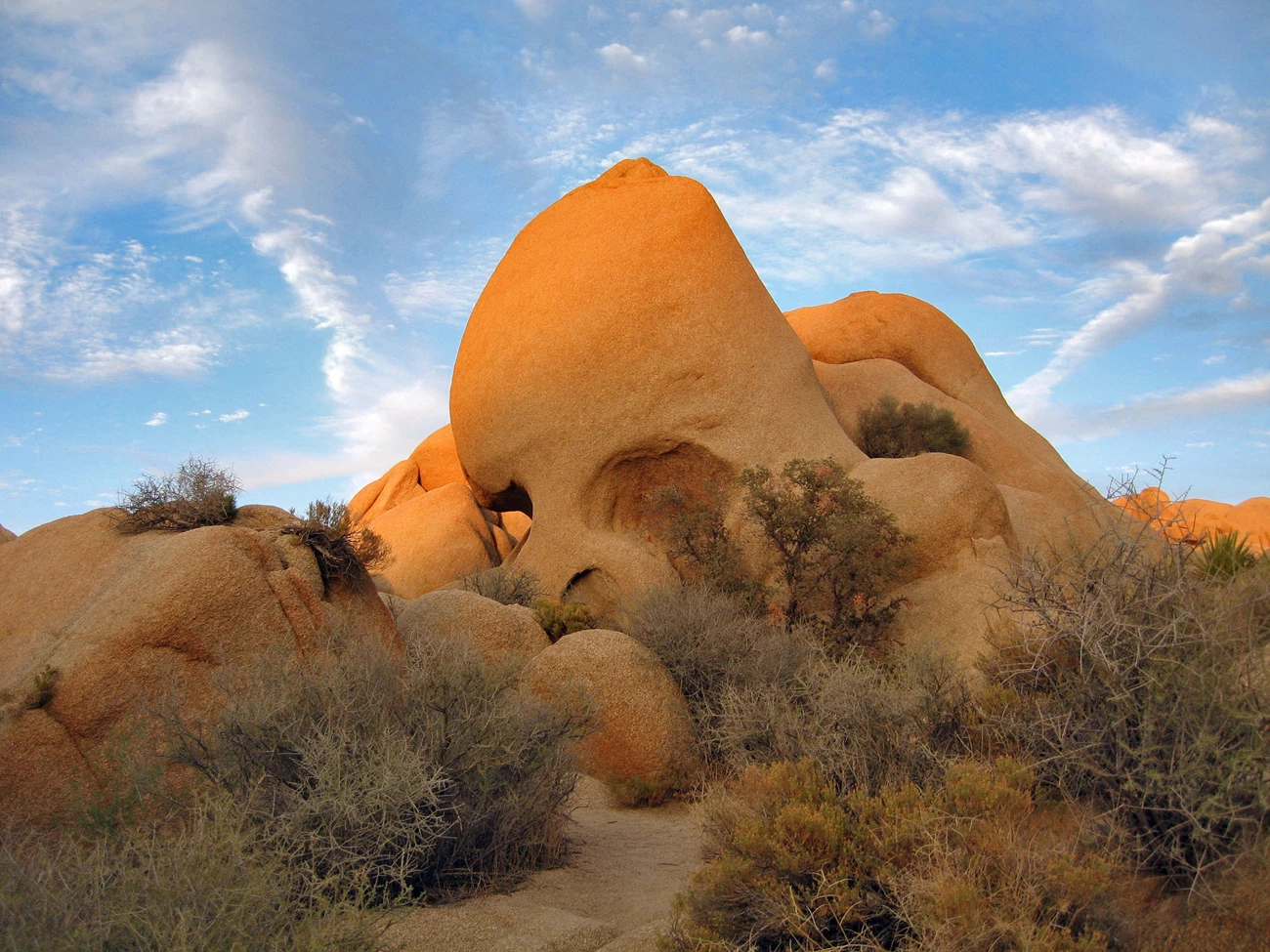
NPS / Robb Hannawacker Trail InformationStart this dirt trail across the road from the entrance to Jumbo Rocks Campground, at the Skull Rock parking lot, or from within the campground. If you go counterclockwise from the parking lot, the trail proceeds north of Park Boulevard through Mojave mid-elevation mixed scrub and riparian corridors, where you will see cat’s claw acacia and desert almond dominating the sandy areas. After crossing Park Boulevard you will see oak woodlands among the boulders, with California buckwheat and Mojave yucca along the ridgelines. This trail has many interpretive signs along the path and takes you by the famous Skull Rock. The last stretch of the loop follows the paved road through the campground. The loop is 1.8 miles (2.9 km) with an elevation gain of 120 feet (37 m).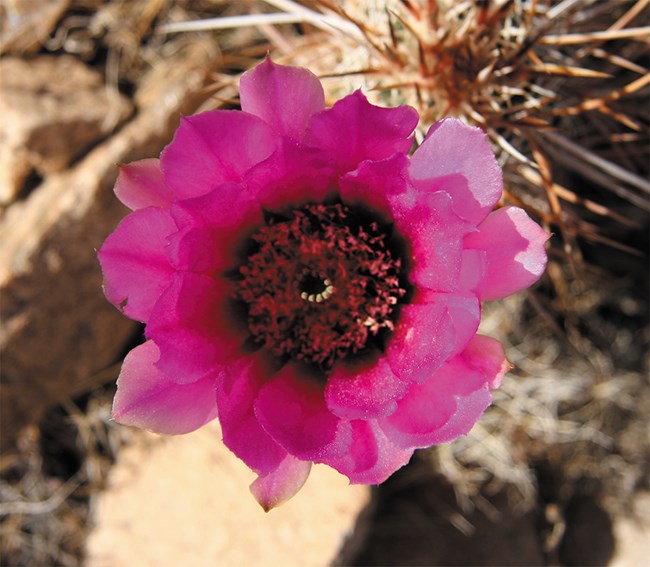
Hedgehog CactusEchinocereus engelmanniiMay–June One of our more common cacti, this species forms clumps of upright, cylindrical stems. In the spring, you can identify it easily by its brilliant magenta flowers, along with the dense clusters of calico-colored spines. The hedgehog cactus relies heavily on bees for pollination. The flowers avoid self-pollinating by only opening the stigma lobes (female reproductive parts) after the bees have carried the pollen away. This is called protandry. 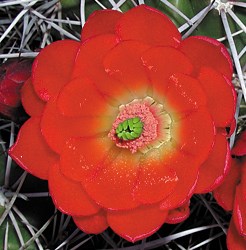
Mojave Mound CactusEchinocereus mojavensisApril–June Like all members of the Cactaceae, the flowers of the Mojave mound cactus consist of many tepals, which means the petals and sepals cannot be distinguished. This is the only cactus with bright red flowers in California and it is also the only cactus pollinated by hummingbirds in this region! You will find it growing in low mounds of densely packed stems, which can reach nine feet across. 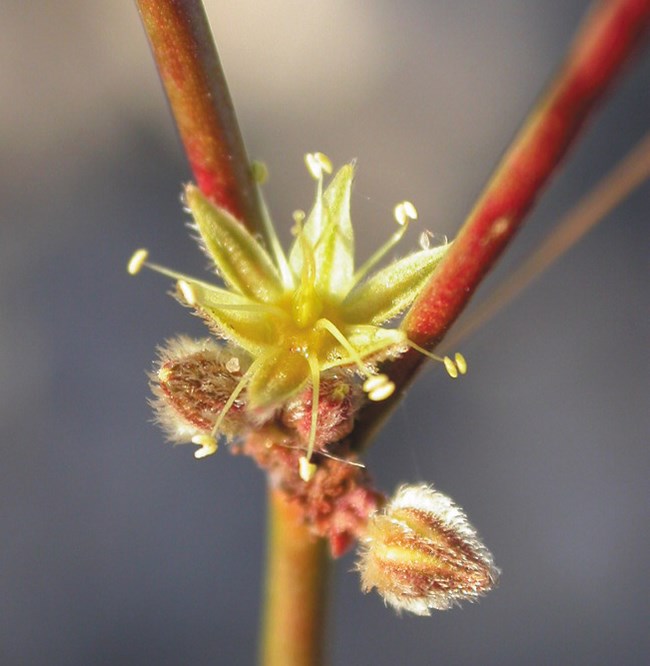
James Andre Desert TrumpetEriogonum inflatumall year Despite lacking a showy flower, desert trumpet stands out at any time of the year because of its inflated stems. The fistulose (hollow) portion of the stem occurs just below the whorl of branches. The amount of inflation is dependent on available moisture and is caused by carbon dioxide concentration. During drier periods of the year, the inflation will be less pronounced or lacking altogether. You can find these tall, airy plants throughout the park in a variety of habitats; watch for them along the roadside. 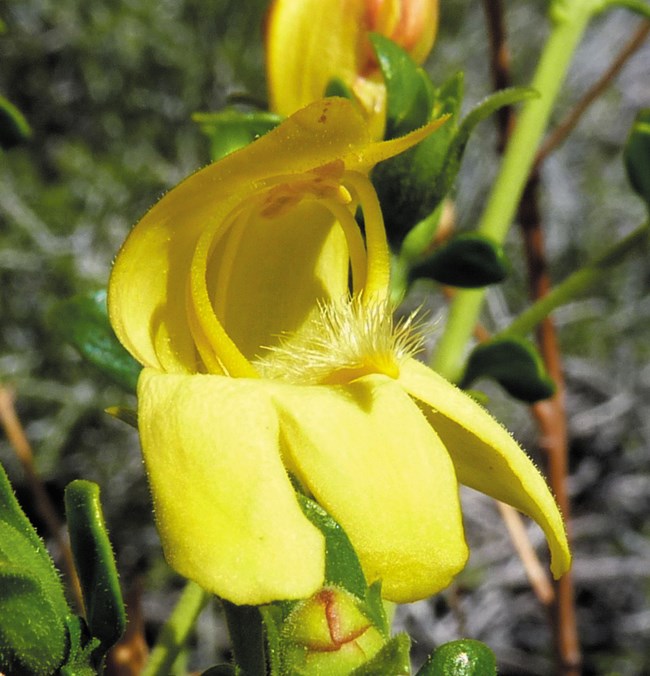
Bush PenstemonKeckiella antirrhinoidesApril–June The bush penstemon, also called a beardtongue, is aptly named. It is in the same family as domestic snapdragons, and like those flowers it has a furry pistil that looks like a “bearded tongue” for gathering pollen from visiting insects. Note the downward-facing, fused petals. These provide a landing platform for pollinators, and the overhanging petals and anthers deposit pollen on the insect while it gathers nectar. This woody shrub is quite showy with its large yellow flowers and shiny green leaves. Look for it on rocky slopes. 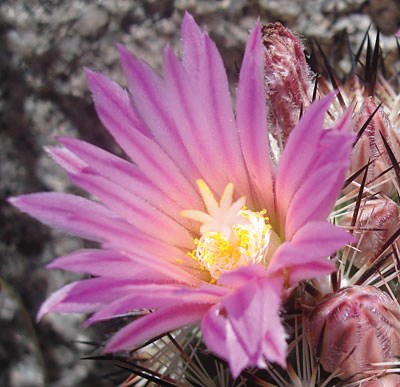
Cushion Foxtail CactusCoryphantha alversoniiApril–June Cushion foxtail cactus, a stem succulent, is known for its brilliant pink bloom and reddish black tipped spines. It can be locally common throughout Joshua Tree National Park, but has a limited distribution. It is restricted to a small region in the transition zone between the Mojave and Sonoran Deserts in California, making it endemic to the state and of conservation concern. 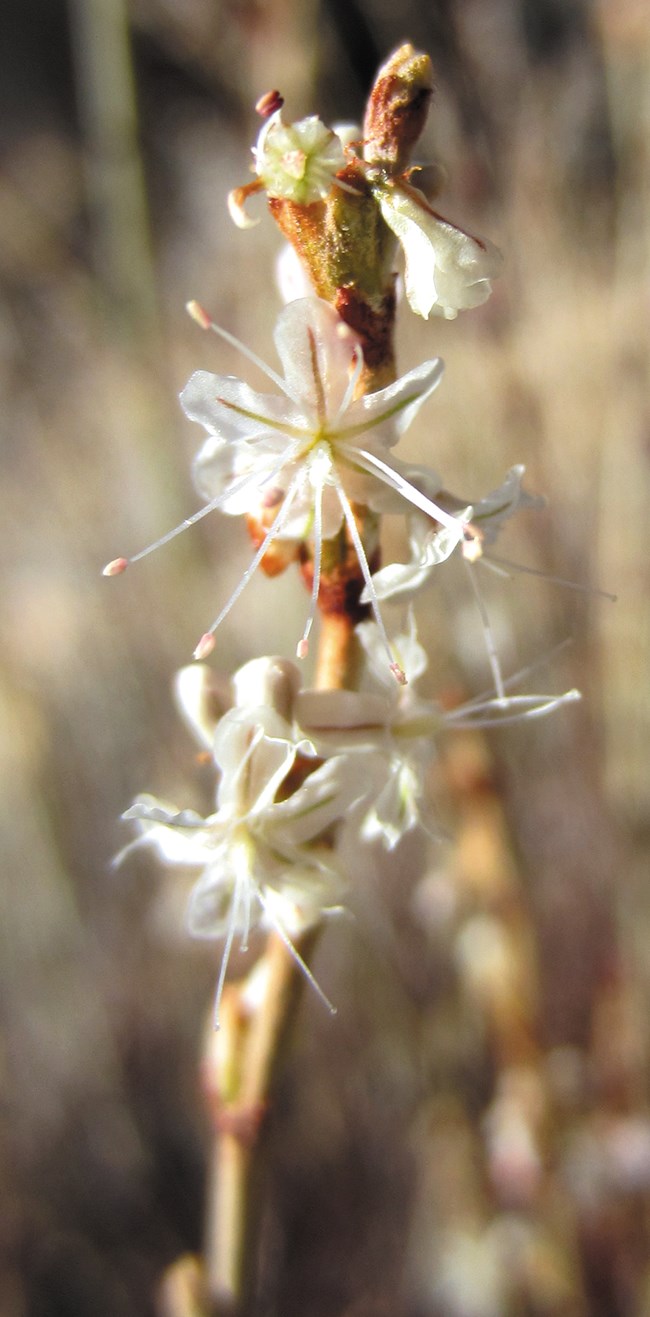
Wright's BuckwheatEriogonum wrightiiAugust–February The sweet nectar of Wright’s buckwheat provides nourishment for a great diversity of native bee pollinators, as well as butterflies such as the beautiful Mormon metalmark. This common but unassuming shrub reminds us that by protecting our native vegetation we also protect a multitude of other species. 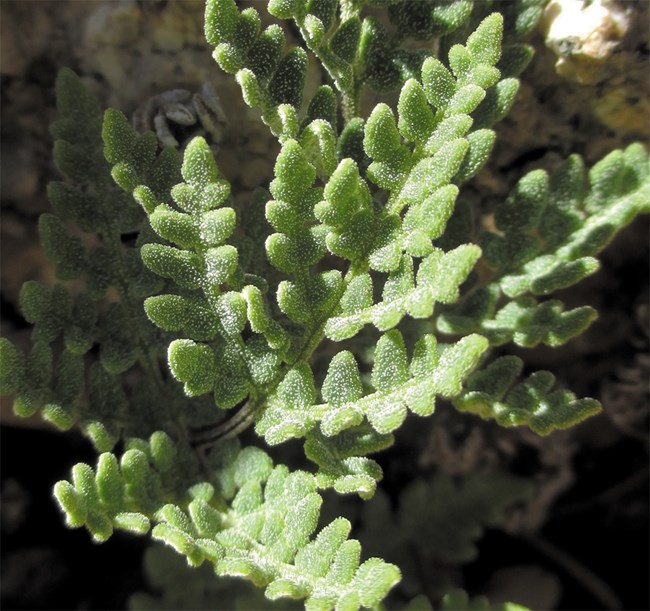
Viscid Lip FernMyriopteris viscidaThe name, viscid lip fern, refers to the clear sticky substance exuded from the dense covering of glands on the leaf surfaces. Many members of the genus Myriopteris produce chemicals that help to block certain types of UV radiation, effectively protecting themselves from sun damage in harsh, xeric landscapes. You will find this plant in protected, rocky areas. 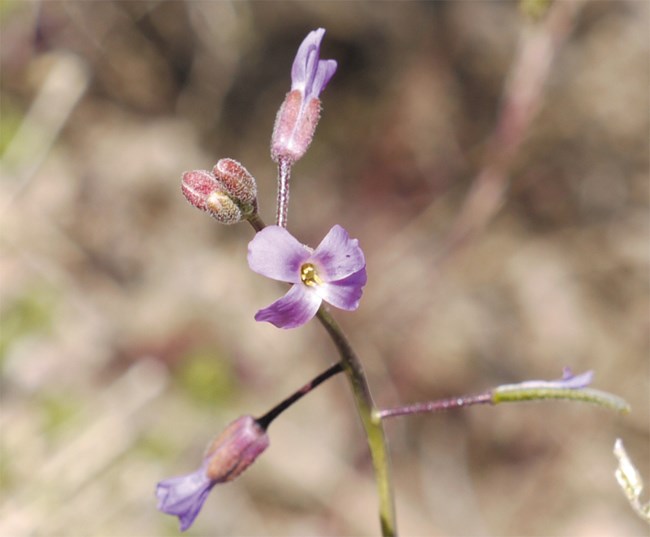
Bigfoot Hybrid RockcressBoechera xylopodaMarch–May You will typically find the bigfoot hybrid rockcress growing on gravelly slopes, rocky outcrops, or in the shade of a tree. The erect flowering stalk emerges from a small rosette of dark green leaves and the flowers have four purple petals. The skinny fruits, called siliques, are quite noticeable on these plants and are often covered with small stellate (star-shaped) hairs. 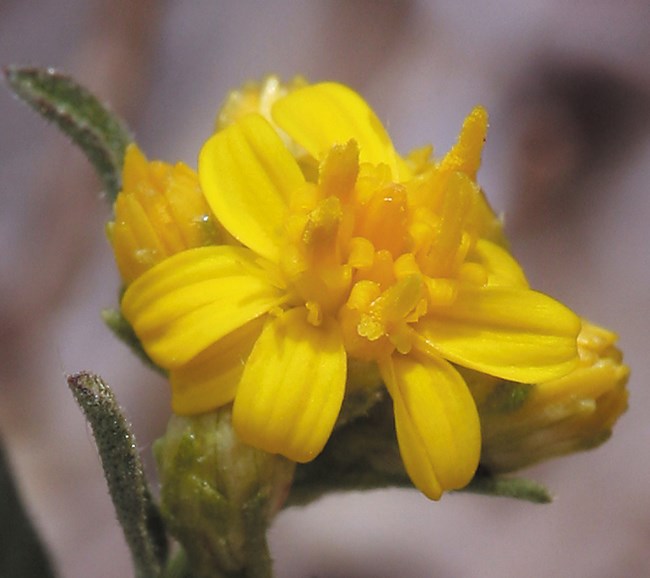
Steve Matson Broom MatchweedGutierrezia saronthraeMay–October Broom matchweed is highly aromatic and flammable due to the resins in the leaves – hence the common name matchweed. The aromatic compounds lend it healing properties: for example, the Cahuilla used the plant as a cure for toothaches and other pains. The name sarothrae means “broom” in Greek, referring to the densely branched herbaceous stems that work well as a broom. 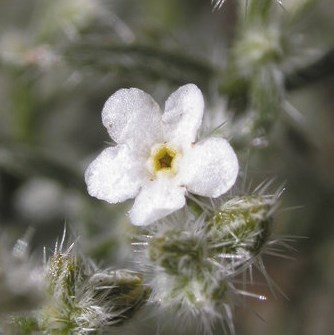
James Andre Woody Forget-me-notCryptantha racemosaFebruary–May Although many members of this genus are annuals, the woody base of this species helps to distinguish it as a perennial. You can find woody forget-me-not growing from rock crevices, often along canyon walls. The small, white flowers and bristly hairs make the members of this genus difficult to tell apart, but if you can get a closer look at the nutlets (seeds) you will see a myriad of differences. The species name comes from the Latin meaning for “clustered,” referring to the shape of the flowering stalk. 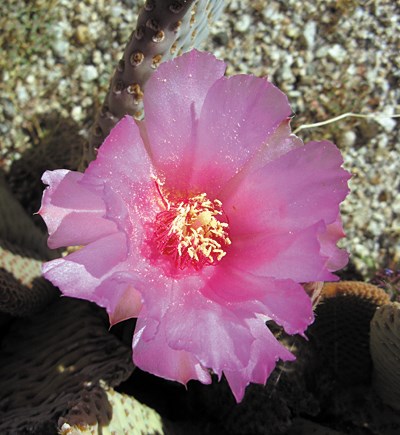
Beavertail CactusOpuntia basilarisMarch–June This cactus has flat, blue-gray pads that are spineless and appear fuzzy and soft, tempting people to make the mistake of touching them. Beware: instead of spines, they are armed with many small bristles known as glochids, which are painful and very difficult to remove! The species name basilaris means “regal,” referring to the plant’s beauty when covered with large, nearly neon pink flowers. Ants can often be found swarming the newly formed pads and flowers due to the copious amounts of nectar they produce. Native Americans traditionally used beavertail cactus for both food and medicine. 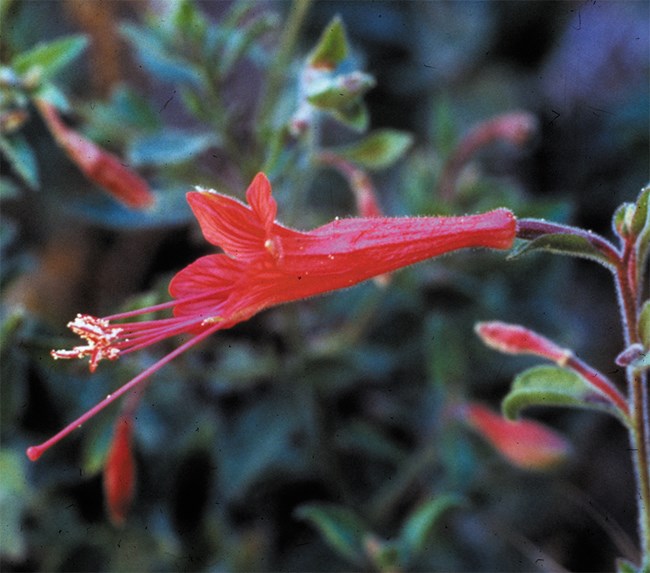
California FuschiaEpilobium canumJune–December An herbaceous perennial, California fuschia grows in the bottoms of canyons, along washes, or wherever there is moisture seeping from a crevice. Look for it during the summer and fall months, when it is covered in tube-shaped red to orange flowers. These flowers exhibit the classic morphology of a plant pollinated by birds: the red color is highly visible; the tubular shape holds nectar at the base, requiring the bird to get pollen on its face as it delves deep for food; and there is little scent.
| ||||||||||||||||||||||||||||||||||||||||||||||||||||||||||||||||||||||||||||||||||||||||||||||||||||||||||||||||||||||||||||||||||||||||||||||||||||||||||||||||||||||||||||||||||||||||||||||||||||||||||||||||||||||||||||||||||||||||||||||||||||||||||||||||||||||||||||||||||||||||||||||||||||||||||||||||
Last updated: February 12, 2021
